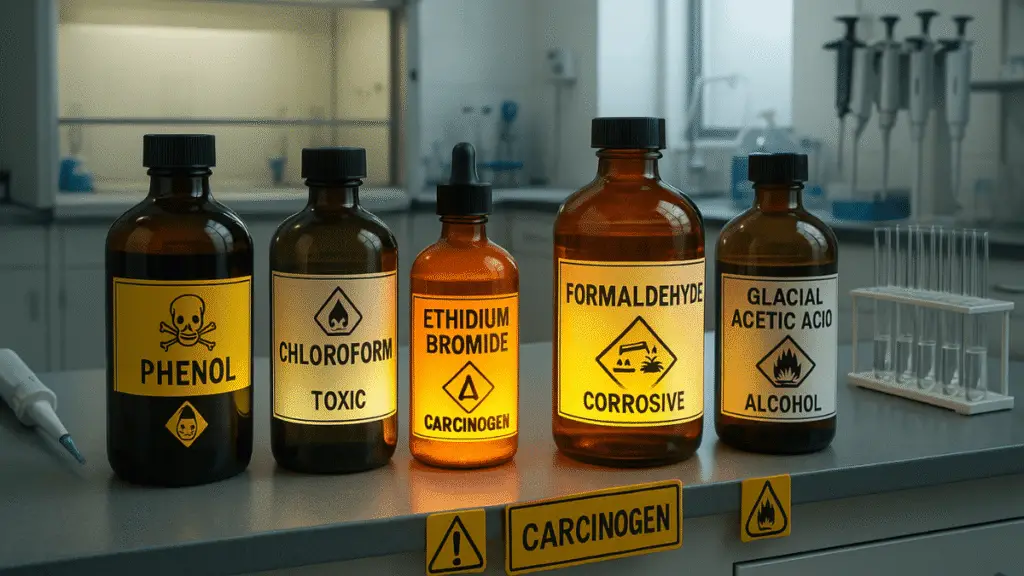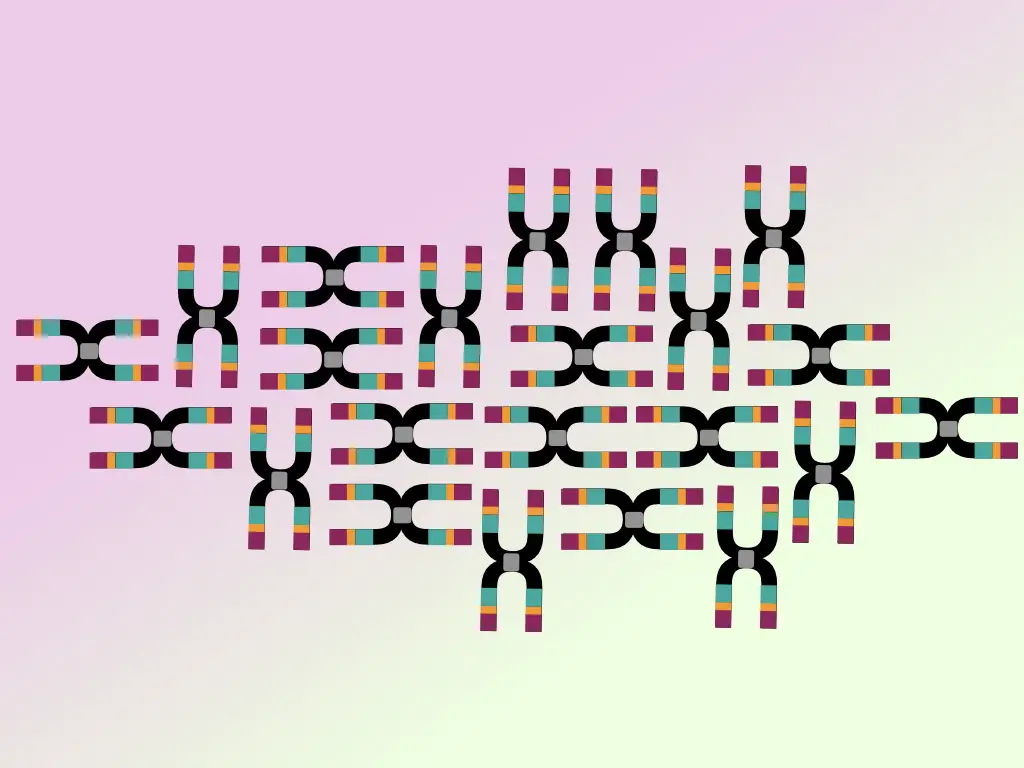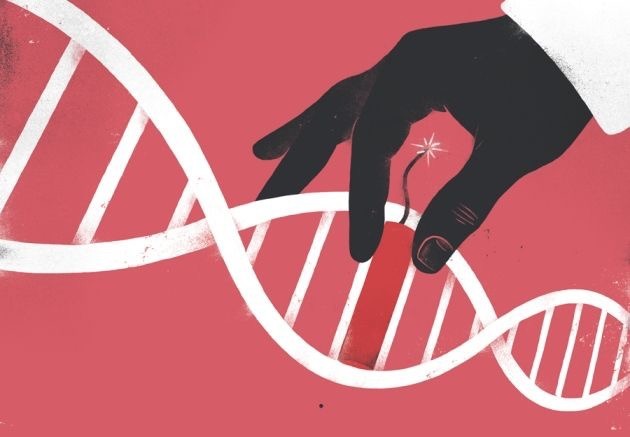Working in a state-of-the-art genetic laboratory is a dream for millions of life sciences students. I am one among many lucky research scholars who worked in genetic labs and built my own from scratch.
A genetic lab is a specialized space that requires dedicated training to work in. You need to train to work with microvolume samples, extensive pipetting, standardization procedures and safety protocols, obviously.
When it comes to safety, several chemicals require special attention in a genetic lab. Here I am listing 7 common hazardous chemicals used in a genetic lab and how to handle them.
Stay tuned.
Key Topics:
Top 5 Hazardous Chemicals in a Genetics Lab
Every chemical is, to some extent, hazardous or toxic. Phenol, chloroform, alcohol, formaldehyde, EtBr, agarose powder and glacial acetic acid are commonly used in a genetic lab and are highly toxic.
Let’s explain them one by one.
Phenol:
Phenol is the most common and popular ingredient you will find in the genetic lab. It is often used as a key ingredient in the DNA extraction process. It is used to remove the impurities from the DNA.
However, it’s too dangerous!
Phenol is an organic compound that is toxic, hazardous and corrosive. It burns the skin by contact, toxicates and irritates the respiratory system by inhalation and can damage our kidneys and other vital organs if ingested.
Chloroform:
Yet another common among many DNA extraction chemicals in a genetic lab is chloroform. It has anesthetic properties. Inhalation can lead to unconsciousness or coma. It is toxic (for the liver, kidney and reproductive system), carcinogenic, and an irritant to skin and eyes. It is also an environmental hazard.
EtBr:
Ethidium Bromide is commonly used during the gel electrophoresis procedure and is least popularly used during karyotyping (If you know how, comment below and let me know).
It is an intercalating dye that interacts with the double-stranded DNA and emits fluorescence. EtBr is a potential mutagen and carcinogen. Upon absorption by the skin, it can damage our DNA and lead to cancer.
Agarose powder:
Agarose powder is commonly used to prepare the gel during electrophoresis, and is a common molecular lab chemical. It’s a polysaccharide extracted from seaweed. It is toxic and hazardous.
Dust causes respiratory and eye irritation, coughing and throat discomfort and eye redness. Prolonged skin contact causes irritation and dryness. Note that it is combustible, hence avoid using it under an open flame.
Formaldehyde:
You might have a doubt; formaldehyde is used in a histology lab as a sample preservative. Formaldehyde is often used during FISH to fix the cells or tissues. It can be used for advanced karyotyping analysis but not in routine.
However, it is flammable and hazardous.
Firstly, it is highly flammable in liquid and even in vapor form. So keep it away from open flames or sparks. IARC (International Agency for Research on Cancer) classified formaldehyde as a human carcinogen. Long-term exposure causes leukemia and nasopharyngeal cancer.
When inhaled, it causes strong irritation to the respiratory tract and leads to a cough and sore throat. Note that long-term exposure leads to asthma-like symptoms. It is also a skin and eye irritant and causes permanent eye damage.
Formaldehyde ingestion is highly toxic and fatal and also causes severe stomach and intestinal damage.
Alcohol:
Different alcohols in different concentrations are widely used in a genetic lab to precipitate and wash the DNA and as a fixative for karyotyping slide preparation. It is also a common lab chemical used as a disinfectant.
Alcohol is highly flammable and irritates the eyes and the respiratory tract. Ingestion in an extensive amount is toxic and often causes central nervous system depression.
Glacial acetic acid:
GAA is extensively used during karyotyping as a fixative agent. It is highly corrosive and causes skin burns and eye damage. It can also damage the respiratory tract when inhaled. GAA ingestion is highly toxic and potentially fatal.
Summary:
| Rank | Chemical | Major Hazards | Toxic/carcinogen |
| 1 | Phenol | Highly corrosive, systemic toxicity, burns | Toxic, Possible Carcinogen |
| 2 | Ethidium bromide | DNA intercalator, mutagen, carcinogen | Highly Carcinogenic & Mutagenic |
| 3 | Formaldehyde | Strong irritant, respiratory hazard, carcinogen | Confirmed Carcinogen |
| 4 | Chloroform | CNS depressant, hepatotoxic, carcinogen risk | Toxic, Suspected Carcinogen |
| 5 | Glacial acetic acid | Highly corrosive, causes severe burns | Toxic |
| 6 | Alcohol | Flammable, inhalation risk | Irritant, Mild Toxicity |
| 7 | Agarose powder | Dust inhalation irritant and, respiratory hazard | Low Toxicity (Irritant) |
Precautions:
We already wrote an article on genetic lab safety. I am giving some actionable suggestions in short.
- Take training for lab safety first.
- Wear a lab coat, gloves, face mask and most importantly, an eye protector during experimentation.
- Follow the working SOP for each chemical separately. For instance, formaldehyde can’t be processed in a fume hood, as it is highly corrosive.
- Avoid direct chemical contact and ingestion.
- Most importantly, label all the hazardous chemicals separately and correctly.
- Must follow emergency protocol in case of an accident and immediately ask for medical support (Don’t use your brain).
Wrapping up:
This article will give you insight into how to work in a genetic lab; you should take special care while handling these chemicals. Again, I am mentioning from my personal experience: strictly follow the SOP while handling these chemicals.
For more lab tips, notes and educational material, subscribe to Genetic Education.


